the place where Paleontology and Paleoanthropology meets Philately
Mexico
Dinosaurs and other prehistoric animals, Natural History Museums on stamps and postmarks of Mexico
| << previous country | back to index | next country >> |
Contents:
- Country overview
- Philately of Mexico
- Official stamps of Mexico related to Paleontology
- Other stamps of Mexico to consider
- Commemorative postmarks of Mexico related to Paleontology
- Other postmarks of Mexico to consider
- References
- Acknowledgements
Mexico, officially the United Mexican States is a country in the southern half of North America. It is bordered to the north by the United States; to the south and west by the Pacific Ocean; to the southeast by Guatemala, Belize, and the Caribbean Sea; and to the east by the Gulf of Mexico.
Covering almost two million square kilometers. With an estimated population of over 120 million, it is the eleventh most populous country and the most populous Spanish-speaking country in the world while being the second most populous country in Latin America.
Pre-Columbian Mexico traces its origins to 8,000 BC and is identified as one of the six cradles of civilization; it was home to many advanced Mesoamerican civilizations, most notably the Maya and the Aztecs. In 1521, the Spanish Empire conquered and colonized the region from its base in Mexico City, establishing the colony of New Spain.
Mexico declared independence from Spain on September 16, 1810. This resulted in the long Mexican War of Independence which ended in 1821, and which eventually led to the creation of the short-lived First Mexican Empire.
Two years later, he was deposed by the republican forces. In 1824, a republican constitution was adopted, creating the United Mexican States with Guadalupe Victoria as its first President. Mexico is a federation comprising thirty-one states and a Federal District, its capital and largest city. [R1]
In 1891, the postal and stamp issuing authority was created as an administrative division of the Secretaría de Comunicaciones (Secretariat of Communications). It was called Servicio Postal Mexicano (Sepomex). In 1901, the Dirección General de Correos (General Direction of Mail) was made a separate government agency. The Palacio de Correos de Mexico has been used since 1907 as the main post office.
The Mexican Revolution and ensuing Civil Wars (1910–1920) resulted in numerous provisional and local stamps issued by the factions in control of different areas of the country.
In 1856, Mexico issued its first adhesive postage stamps, with "district overprints", a unique feature among postal systems worldwide, employed to protect from theft of postage stamps. [R2]
Official stamps of Mexico related to Paleontology: dinosaurs and other prehistoric animals
| 29.09.2006 "Dinosaurs of Mexico" | 18.10.2011 "Health and Safety in Mexico" [1] | 28.07.2023 "Prehistoric Dimensions" |
 |
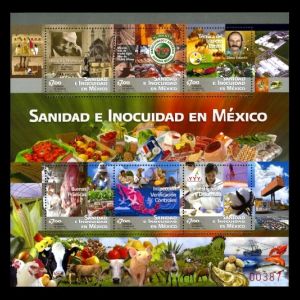 |
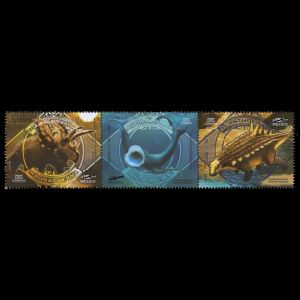 |
Notes:
[1] In October 2011, Post of Mexico issued a Mini-Sheet with 6 stamps with subject "Health and Safety in Mexico".
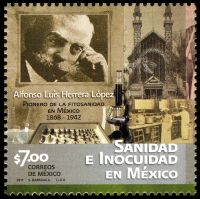
|
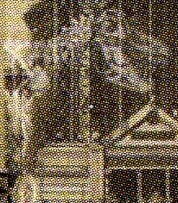
|
| Alfonso Luis Herrera on stamp of Mexico 2011 MiNr.: 3675, Scott: 2757a | Theropod dinosaur on background of Alfonso Luis Herrera on stamp of Mexico 2011 |
The first stamp in upper row is dedicated to Alfonso Luis Herrera (3 July 1868 – 1942) who was a Mexican biologist, author, educator and founder of several institutions in Mexico City.
Herrera was born in Mexico City, the son of a well-known naturalist.
He studied Pharmacy at the National School of Medicine, graduating in 1889 by which time he had already published several papers in Zoology and Ornithology.
An active promoter of Darwinian ideas in Latin America, Herrera was also among the first 20th century researchers to attempt to “create life in a test tube.”
Herrera’s thinking went beyond the evolution of living beings, and extended to the question of the origin of life itself and the place of living phenomena in the larger context of the cosmos. [R3]
By looking closer on the stamp, it is possible to see a dinosaur's skeleton in the background. More details are here.
Other stamps of Mexico to consider: Natural History Museums
| 26.05.1986 "Century of Geology Museum of Mexico City" | ||
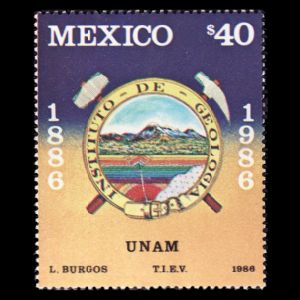 |
|
|
Commemorative postmarks of Mexico related to Paleontology: dinosaurs and other prehistoric animals
Legend is here| 14.10.1984 "III Congress of Paleontology in Latin America" [Sp] | 29.09.2006 "Dinosaurs of Mexico" [FDC]; | 28.07.2023 "Prehistoric Dimensions" [FDC] |
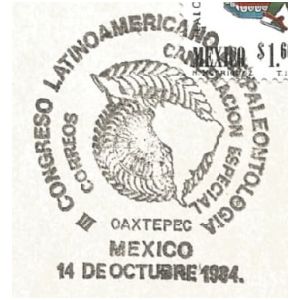 |
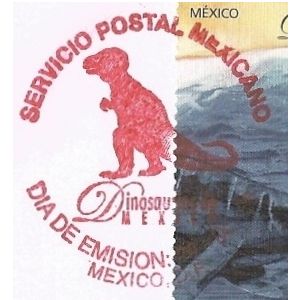 |
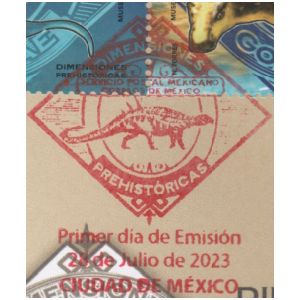 |
Other postmarks of Mexico to consider: Natural History Museums
Legend is here| 26.05.1986 "Century of Geology Museum of Mexico City" [Sp] [CA1] | ||
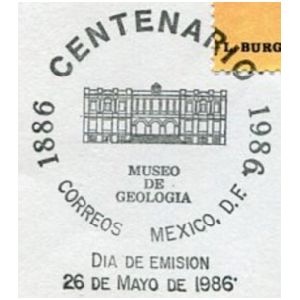 |
|
|
Notes:
[CA1] The Museum not only contains minerals, but also has paleontologic collections.
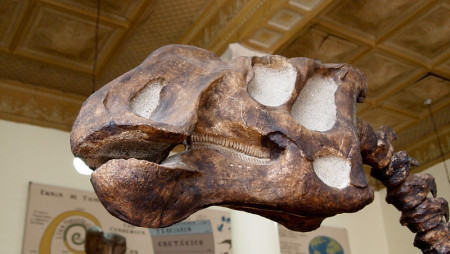 |
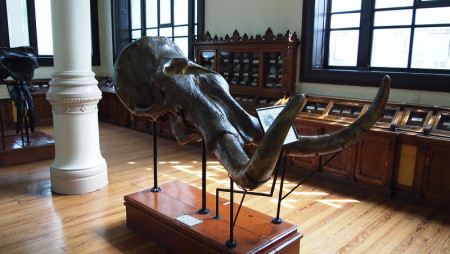 |
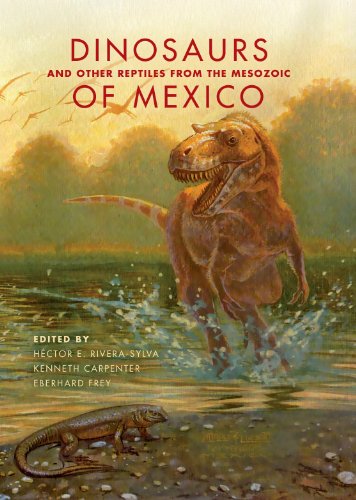 Dinosaurs and Other Reptiles from the Mesozoic of Mexico, by Héctor E. Rivera-Sylva and Kenneth Carpenter.
Dinosaurs and Other Reptiles from the Mesozoic of Mexico, by Héctor E. Rivera-Sylva and Kenneth Carpenter.
Amazon: USA, UK, DE This overview of dinosaur discoveries in Mexico synthesizes current information about the geography and environment of the region during the Mesozoic when it was the western margin of the ancient continent of Pangea. The book summarizes research on various groups, including turtles, lepidosauromorphs, plesiosaurs, crocodyliforms, pterosaurs, and last but not least, dinosaurs. "Dinosaurs and Other Reptiles from the Mesozoic of Mexico" is an up-to-date, informative volume on an area that has not been comprehensively described until now. |
- [R1] Mexico: Wikipedia, WikiTravel FlagCounter
- [R2] Postal History and Philately of Mexico:
Wikipedia,
Links to official website of the Post Authority, stamp catalog and a list of new stamps of Mexico are here - [R3] Alfonso Luis Herrera: Wikipedia,
Acknowledgements:
- Many thanks to Dr. Peter Voice from Department of Geological and Environmental Sciences, Western Michigan University, for reviewing the draft page and his valuable comments.
- Many thanks to fellow collector Mr. Maxim Romashchenko from Canada, for his help in finding some missing philatelic stuff of Mexico.
| << previous country | back to index | next country >> |